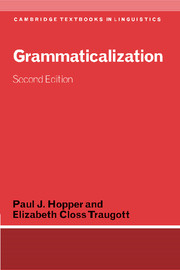Book contents
- Frontmatter
- Contents
- List of figures
- List of tables
- Preface and acknowledgments
- List of abbreviations
- 1 Some preliminaries
- 2 The history of grammaticalization
- 3 Mechanisms: reanalysis and analogy
- 4 Pragmatic factors
- 5 The hypothesis of unidirectionality
- 6 Clause-internal morphological changes
- 7 Grammaticalization across clauses
- 8 Grammaticalization in situations of extreme language contact
- 9 Summary and suggestions for further work
- Notes
- References
- Index of names
- Index of languages
- General index
2 - The history of grammaticalization
Published online by Cambridge University Press: 05 June 2012
- Frontmatter
- Contents
- List of figures
- List of tables
- Preface and acknowledgments
- List of abbreviations
- 1 Some preliminaries
- 2 The history of grammaticalization
- 3 Mechanisms: reanalysis and analogy
- 4 Pragmatic factors
- 5 The hypothesis of unidirectionality
- 6 Clause-internal morphological changes
- 7 Grammaticalization across clauses
- 8 Grammaticalization in situations of extreme language contact
- 9 Summary and suggestions for further work
- Notes
- References
- Index of names
- Index of languages
- General index
Summary
Introduction
Grammaticalization is the study of grammatical forms, however defined, viewed not as static objects but as entities undergoing change. It has had many practitioners, has been characterized in many different ways, and has occupied at various times both central and marginal positions in linguistics. In this chapter we will survey briefly the thought of some of the major figures in the early study of grammaticalization, mention some of the contemporary linguists who are interested in the subdiscipline, and briefly summarize some of the more recent developments. Other surveys of the history of grammaticalization can be found in C. Lehmann (1995 [1982]) and Heine, Claudi, and Hünnemeyer (1991a).
Earlier research on grammaticalization
The term “grammaticalization” itself was apparently coined by the French linguist Antoine Meillet, an Indo-Europeanist who at one time had been a student of Saussure. In a well-known definition, Meillet writes of “the attribution of grammatical character to an erstwhile autonomous word” (“l'attribution du caractère grammatical à un mot jadis autonome”; Meillet 1912: 131). Yet Meillet's ideas on the origins of grammatical forms have predecessors in earlier speculations that were often rooted in assumptions about the evolutionary development of human speech.
Perhaps the most sophisticated of these speculations about the origins of grammar was that proposed by the German philosopher and humanist Wilhelm von Humboldt (1767–1835). In a published lecture entitled “On the genesis of grammatical forms and their influence on the evolution of ideas” (“Über das Entstehen der grammatikalischen Formen und ihren Einfluß auf die Ideenentwicklung”) given in 1822 he suggested that the grammatical structure of human languages was preceded by an evolutionary stage of language in which only concrete ideas could be expressed.
- Type
- Chapter
- Information
- Grammaticalization , pp. 19 - 38Publisher: Cambridge University PressPrint publication year: 2003

